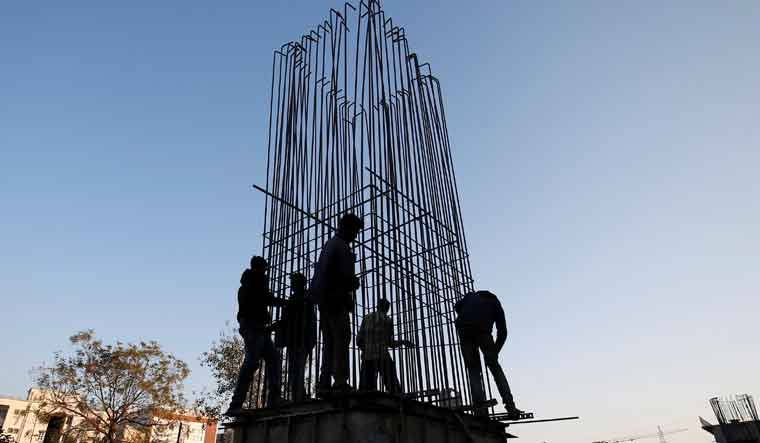India’s economy took a huge hit last year as the government imposed strict lockdowns to curb the rapid spread of COVID-19. However, it seems to have recovered at a fast clip from the record 24.4 percent contraction in the April-June quarter of 2020-21 fiscal as infections have fallen, vaccination rate has improved and demand across sectors has picked up. While most analysts expect the pickup to continue in the coming quarters, ongoing supply-side bottlenecks and emergence of new coronavirus variants do pose a risk, they add.
Data released by the National Statistical Office on Tuesday showed the economy grew at 8.4 percent in the July-September quarter. While this was slower than the 20.1 percent GDP growth recorded in the June quarter due to base effects, it was still faster than the 7.4 percent contraction in the year ago quarter.
In absolute terms, India’s second quarter GDP at Rs 35.7 trillion is higher than in the second quarter of 2019-20, a pre-COVID year, note analysts.
The growth was driven by a sharp increase in public expenditure in the second quarter of the current financial year, after conservative spending in the June quarter, according to M Govinda Rao, chief economic adviser at Brickwork Ratings.
Public administration, defence and other services recorded a growth of 17.4 percent in September, compared with the contraction of 9.2 percent in the second quarter last year.
While growth in contact intensive sectors like trade, hotels, transport, storage and communication at 8.4 percent was also “impressive,” growth in manufacturing sector at 5.5 percent was a “bit disappointing,” said Rao, who was a member of the 14th finance commission.
As we look forward, uncertainties remain. Supply-side issuess in areas like semiconductors continue to hurt production of automobiles and consumer durables. Furthermore, emergence of a new COVID-19 strain is a cause for worry for sectors like travel, tourism and retail.
“Looking ahead, the outlook is more mixed, with improving mobility, but supply-side bottlenecks bogging down production, alongside signs of weakness in demand for mass consumption goods,” said Sonal Varma, managing director and chief economist for India and Asia ex-Japan at Nomura Securities.
Factors such as better adapted firms, policy response, stable financial conditions, global growth spill-overs, and improved vaccine drive have created growth buffers back home, said Madhavi Arora, lead economist at Emkay Global Financial Services.
“The emerging uncertainties from Omicron (COVID variant) and consequent supply bottlenecks could be countered by healthy consumer demand and high household savings, continued government spending, and considerable wealth effects. However, we reckon that the nascent recovery ahead have traces of scarring and segmented labor market. Further, exogenous demand drivers in the form of exports and sustained government capex will need to create a growth bridge till private investment and consumption recover optimally,” said Arora.
The monetary policy committee of the Reserve Bank of India will be closely watching these growth parameters as it prepares for its next meeting in the coming week. Suvodeep Rakshit, senior economist at Kotak Institutional Equities feels that with the new COVID variant starting to spread globally and its impact on the economy uncertain, RBI would possibly wait for more clarity before decisively moving on interest rates.
He still expects the RBI to raise the reverse repo rate (rate at which a central bank borrows short-term money from banks) in February, with the December meeting “remaining a close call.”
Nomura’s Varma still expects the RBI MPC to raise reverse repo rate by 40 basis points in December, although there are now risks of some of it getting pushed to the February meeting.
Overall Nomura expects a cumulative 75 bps hike in repo and reverse repo rates in 2022.
On the GDP front, analysts for now do expect growth to be in-line with earlier expectations.
“Growth should remain fairly well supported in third quarter too on account of festive season and opening up of services sector. Growth remains well on track for a full year growth of around 9.5 percent,” said Rakshit.
Nomura’s Varma expects GDP growing 9.2 percent in the year-ending March. Govinda Rao of Brickwork has penciled in a higher GDP growth in the 10 percent to 10.5 percent range.
Suman Chowdhury, chief analytical officer at Acuite Ratings & Research sees GDP growth at 10 percent in the current financial year, although there are “moderate headwinds in the third and fourth quarter due to high commodity prices that can impact demand and the risks of another wave of the pandemic.” Indranil Pan, chief economist at Yes Bank, sees GDP growing 9.3 percent this year.
RBI’s full year GDP growth forecast is at 9.5 percent.
“Uncertainty on the new virus variants, normalising global growth and domestic inequalities are likely to remain headwinds for a sustained growth momentum,” said Pan.





